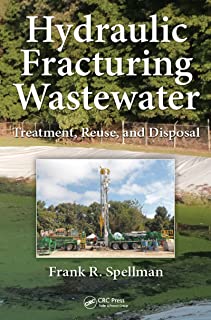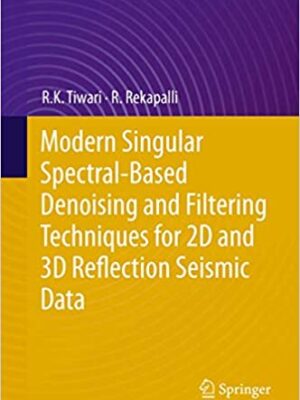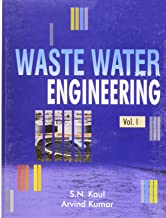Environmental Microbiology for Engineers
Original price was: ₹11,847.00.₹9,477.60Current price is: ₹9,477.60.
ISBN: 9781498702126
Author/Editor: Volodymyr Ivanov
Publisher: CRC Press
Year: 2015
1 in stock (can be backordered)
Description
The second edition of Environmental Microbiology for Engineers explores the role that microorganisms play in the engineered protection and enhancement of an environment. Offering a perfect balance of microbiological knowledge and environmental biotechnology principles, it provides a practical understanding of microorganisms and their functions in the environment and in the environmental engineering systems. The book also presents a quantitative description of applied microbiological processes and their engineering design. This updated edition adds a new chapter on construction biotechnology, and offers new end-of-chapter exam questions with solutions to aid readers with performing the design calculations needed and to enhance understanding of the material.
The book covers essential topics that include:
Diversity and functions of microorganisms in environmental engineering systems
Environmental bioengineering processes
Applied microbial genetics and molecular biology
Microbiology of water and wastewater treatment
Biotreatment of solid waste and soil bioremediation
Microbial monitoring of environmental engineering systems
Biocorrosion and biodeterioration of materials
Biocementation and bioclogging of soil
Biopollution of indoor environment
Biofouling of facilities, and more
Environmental Microbiology for Engineers provides a practical understanding of microorganisms in the civil engineering process and their functions in the environmental engineering systems, and is designed for practicing environmental engineers working in the areas of wastewater, solid waste treatment, soil remediation and ground improvement.
Additional information
| Weight | 0.8 kg |
|---|
Product Properties
| Year of Publication | 2015 |
|---|---|
| Table of Contents | Microorganisms Systems Self-Organized Systems Life as Self-Organized Growth of Biomass Cells Organisms and Microorganisms Size of Microorganisms Biology Microbiology Environmental Microbiology Why Are Microbes Used in Environmental Engineering? Organisms of Importance in Environmental Microbiology Viruses Subviral Particles Importance of Viruses in Environmental and Civil Engineering Prokaryotes Bacteria and Archaea Importance of Prokaryotes in Environmental and Civil Engineering Fungi Importance of Fungi in Environmental and Civil Engineering Algae Importance of Algae in Environmental Engineering Protozoa Importance of Protozoa for Environmental Engineering Chapter 1 Quiz Static Biochemistry Static and Dynamic Biochemistry Chemical Features of Life Balance of Elements Covalent Bonds Organic Compounds and Functional Groups Polarity of Chemical Bonds Water pH of Solutions Intermolecular Forces Hydrophobic Substances and Hydrophobic Forces Stereoisomers Biological Monomers and Polymers Monosaccharides Oligosaccharides and Polysaccharides Lipids and Membranes Lipid Membranes Membrane Melting and Freezing Amino Acids and Proteins Structure of a Protein Molecule Globular and Fibrous Proteins Denaturation of Proteins Enzymes Coenzymes Nucleotides Cyclic Nucleotides Oligonucleotides DNA Structure DNA Melting DNA as a Carrier of Genetic Information DNA Sequences and Sequencing RNA mRNA tRNA Genetic Code rRNA and Translation 16S rRNA Functions of rRNA in the Ribosome miRNA Summary of the Functions of Monomers and Polymers in a Cell Chapter 2 Quiz Dynamic Biochemistry Levels of Metabolism Biochemical Reactions Major Features of Enzymes Mechanism of Enzymatic Catalysis Specificity of Enzymes Inactivation of Enzymes Classification of Enzymes Environmental Applications of Microbial Enzymes and Coenzymes Coenzymes Units of Enzymatic Activity Control of Individual Biochemical Reactions Effect of Noncompetitive Inhibitors on Enzymatic Activity Effect of Competitive Inhibitors on Enzymatic Activity Control of a Group of Biochemical Reactions Regulation of Enzymatic Activity in the Sequence of Enzymes Regulation of Enzyme Synthesis and Degradation Metabolic Blocks Control of Metabolic Blocks Cyclic AMP and GMP as Whole-Cell Regulators of Metabolism Temporal Control of Cell Metabolism Nitric Oxide as Controller of Metabolism Quorum Sensing Control of Metabolism in the Biosphere Chapter 3 Quiz Biooxidation and Bioreduction Oxidation-Reduction Oxidation Numbers Oxidation of Carbon Oxidation-Reduction during Fermentation Energy Two Sources of Biological Forms of Energy Chemotrophy Chemotrophic Oxidation-Reduction Reactions Chemotrophy: Fermentation Chemotrophy: Anaerobic (Anoxic) Respiration Chemotrophy: Aerobic Respiration Phototrophy Oxygenic and Anoxygenic Phototrophic Oxidation-Reduction Reactions Electron-Transfer Chain Proton Motive Force Oxidative Phosphorylation Biological Forms of Energy Production of Biological Energy in Photosynthesis ATP Yield from Oxidative Phosphorylation ATP Production and Yield from Fermentation ATP Yield from Lithotrophy Long-Term Energy Storage in Cells Relation to Oxygen and Generation of Energy Chapter 4 Quiz Biodegradation Biodegradation and biotransformation Biochemical Reactions of Biodegradation Aerobic, Anoxic, and Anaerobic Biodegradation Biodegraded Substances Biodegradation Rates of Natural Substances Biodegradation Rates Correlate with Turnover Rates Degradation of Storage Polysaccharides Biodegradation of Structural Polysaccharides Biodegradation of Hemicellulose and Pectin Biodegradation of Cellulose Biodegradation of Lignin White-Rot Fungi Biodegradation of Chitin Degradation of Proteins Degradation of Amino Acids Degradation of Nucleic Acids Degradation of Lipids Biodegradation of Chemicals Degradation of Aliphatic Hydrocarbons Degradation of Aromatic Hydrocarbons Biodegradation of Benzene, Toluene, Ethylbenzene, and Xylene Bioremediation of Soil and Water Polluted by BTEX Chemicals Xenobiotics Degradative Plasmids Biodegradation of Chlorinated Hydrocarbons Products of Degradation of Aromatic Hydrocarbons Nonbiodegradable and Biodegradable Polymers Polylactic Acid and Polyhydroxyalkanoates Chapter 5 Quiz Molecular Biology and Genetics Metabolic Blocks of Biosynthesis Energy for Biosynthesis Balance of Energy Excess of Biological Energy Number of Enzymes Genes Noncoding RNA Genes Chromosomes Genomes Genomes of Chloroplasts and Mitochondria The Genome in Comparison with a Book Flow of Genetic Information Genetics, Molecular Biology, Bioinformatics, and Epigenetics Collection of DNA Sequences Nucleus and Nucleoid Plasmids Transposons DNA Replication Speed of DNA Replication Transcription Translation Genetic Code Genome Changes Natural Genetic Recombination in Prokaryotes Conjugation Transformation Transduction Horizontal Gene Transfer DNA Reparation and Mutations Chemical Mutagens Physical Mutagens Biological Mutagens Genetic Adaptation of Microbial Population to Changed Environment Chapter 6 Quiz Bioagents of Environmental and Engineering Bioprocesses Hierarchy of Life Cell Aggregates Microbial Communities and Ecosystems Shapes of Individual and Connected Prokaryotic Cells Prokaryotic Cell Shapes as Evolutionary Adaptation to Environment Inner Structure of Prokaryotic Cells Intracellular Inclusions in Prokaryotic Cells Outer Components of Prokaryotic Cells Cytoplasmic Membrane Vulnerability of the Cytoplasmic Membrane Prokaryotic Cell Walls Origin of Gram-Negative Cells Origin of Gram-Positive Cells Flagella, Fimbriae, and Pili Outer Membrane, Lipopolysaccharides, and S-Layer Glycocalyx and Capsule Anabiotic Prokaryotic Cells Structure of Eukaryotic Cells Organelles Chapter 7 Quiz Reproduction, Proliferation, and Growth Reproduction of Viruses Reproduction of Prokaryotes Vegetative Reproduction of Microscopic Eukaryotes Asexual and Sexual Reproduction of Microscopic Eukaryotes Cell Growth and the Cell Division Cycle Coordination of Cell Cycle Events Periods of Exotrophy and Endotrophy in the Cell Cycle Cell Differentiation Growth and Proliferation of Cell Populations Generation Time and Number of Generations Specific Growth Rate Stoichiometry of Microbial Growth Cell Age and Cell Trophic State Distributions in Microbial Populations Quantification of Microbial Biomass Microscopic Enumeration Flow Cytometry Enumeration Physical Methods of Microbial Biomass Measurement Chemical Methods of Microbial Biomass Measurement Physiological Methods of Microbial Biomass Measurement Biological Methods of Cell Enumeration: Plate Count Biological Methods of Cell Enumeration: Most Probable Number Count Enumeration of Cells and Viral Particles at Low Concentrations Molecular-Biological Methods of Microbial Biomass Quantification Chapter 8 Quiz Microbial Ecology Ecosystems Levels of Ecosystems Ecosystem Boundaries Boundaries of Unicellular Organisms Boundaries of Multicellular Aggregates Boundaries of Microbial Communities in Environmental Engineering Systems Diversity of a Microbial Ecosystem Quantification of Ecosystem Diversity Diversity in an Anaerobic Digester Types of Interactions in Microbial Ecosystems Population Density Determines Interaction Type Commensalism Mutualism Interactions of Microorganisms in Cellular Aggregates Positive Interactions between Animals and Microorganisms Symbiotic Mutualism Positive Interactions between Plants and Microorganisms Symbiosis of Plants and Microorganisms Neutral Competition Amensalism Antagonism Predation Parasitism Microbial Parasites of Plants Microbial Parasites of Human and Animals Effects of Nutrients on Biotic Elements Effects of Nutrients on Yield Effect of Starvation on Microorganisms Effect of Oxygen on Biotic Elements Anoxic Microorganisms Effect of Temperature on Growth Effect of pH on Growth Effect of Osmotic Pressure on Growth Natural Death of Microorganisms Fate of Microorganisms Released into the Environment Chapter 9 Quiz Classification of Viruses and Microorganisms Biological Classification Units of Biological Classification Names of Species Classification of Viruses Groups of Viruses Importance of Viruses for Environmental Engineering Isolation and Collection of Microbial Strains Microbial Collections Classification of Microorganisms Phenotypic Characteristics Genotypic Classification Phylogenetic Classification G+C Content in DNA and Genotypic Classification Comparison of the Steps in Phenotypic and Phylogenetic Identification of Strains Phylogenetic Groups of Prokaryotes Classification of Microscopic Fungi Classification of Microscopic Algae Classification of Protozoa Chapter 10 Quiz Physiological Classification of Prokaryotes Physiology of Prokaryotes Three Types of Chemotrophic Energy Generation Three Types of Phototrophic Energy Generation Evolution of the Earth's Atmosphere and Prokaryotes Contradictions between rRNA-Based Phylogenetic Classification and Physiological Classification of Prokaryotes Absence of Predictive Power in rRNA-Based Phylogenetic Classification Parallelism in Evolution of Genes Periodic Table of Prokaryotes Origin of Prokaryotes in Aquatic, Terrestrial, and Extreme Environments Phototrophic Prokaryotes in the Periodic Table Reasons for Evolutionary Parallelism in the Periods of the Periodic Table of Prokaryotes Geological Synchronization of the Periods in the Periodic Table of Prokaryotes Practical Importance of the Periodic Table of Prokaryotes Chapter 11 Quiz Groups of Anaerobic Prokaryotes The 24 Major Physiological Groups of Prokaryotes Gram-Negative (Aquatic) Chemotrophic Fermenting Bacteria Gram-Positive (Terrestrial) Chemotrophic Fermenting Bacteria Chemotrophic Fermenting Archaea Gram-Negative (Aquatic) Phototrophic Bacteria That Use Products of Fermentation as Electron Donors Gram-Positive (Terrestrial) Phototrophic Bacteria That Use Products of Fermentation as Electron Donors Phototrophic Archaea That Use Products of Fermentation as Electron Donors Chapter 12 Quiz Groups of Anoxic Prokaryotes Gram-Negative (Aquatic), Chemotrophic, Anoxic Bacteria Dissimilatory Sulfate-Reducing Bacteria Iron-Reducing Bacteria Denitrifying Bacteria Gram-Positive (Terrestrial), Chemotrophic, Anoxic Bacteria Chemotrophic, Anoxic Archaea (Methanogens) Gram-Negative (Aquatic), Phototrophic, Anoxic Bacteria Gram-Positive (Terrestrial), Phototrophic, Anoxic Bacteria Phototrophic Archaea That Use Products of Anoxic Respiration as Electron Donors Chapter 13 Quiz Groups of Microaerophilic and Facultative Aerobic/Anaerobic Prokaryotes Evolutionary Adaptations of Facultative Aerobic/Anaerobic and Microaerophilic Prokaryotes Gram-Negative (Aquatic), Chemotrophic, Facultative Aerobic/ Anaerobic Bacteria Gram-Negative (Aquatic), Chemotrophic, Microaerophilic Bacteria Gram-Positive (Terrestrial), Chemotrophic, Facultative Aerobic/ Anaerobic and Microaerophilic Bacteria Chemotrophic, Facultative Aerobic/Anaerobic and Microaerophilic Archaea Gram-Negative (Aquatic), Phototrophic, Facultative Aerobic/ Anaerobic and Microaerophilic Bacteria Gram-Positive (Terrestrial), Phototrophic, Facultative Aerobic/ Anaerobic and Microaerophilic Bacteria Phototrophic, Facultative Aerobic/Anaerobic and Microaerophilic Archaea Chapter 14 Quiz Groups of Aerobic Prokaryotes Functions of Aerobic Prokaryotes Pseudomonads and Their Relatives Slime-Producing Bacteria Phosphate-Accumulating Bacteria Nitrogen-Fixing Bacteria Methanotrophs Oligotrophs Bacterial Parasites of Bacteria Rhizobia Gram-Negative, Chemotrophic, Aerobic Pathogens Ammonium-Oxidizing Chemolithotrophs (Nitrifying Bacteria) Sulfur-Oxidizing, Chemolithotrophic Bacteria Iron- and Manganese-Oxidizing Bacteria Gram-Positive (Terrestrial), Chemotrophic, Aerobic Bacteria Chemotrophic, Aerobic Archaea Gram-Negative (Aquatic), Phototrophic, Aerobic Bacteria Gram-Positive (Terrestrial), Phototrophic, Aerobic Bacteria Phototrophic, Aerobic Archaea Chapter 15 Quiz Public Health and Water Disinfection Saprophytic, Pathogenic, and Opportunistic Microbes Parasites of Humans and Animals Stages of Infectious Disease Transmission of Infection Patterns and Extent of Infectious Disease Cooperation between Epidemiologists and Civil Engineers Infections via Vectors Factors of Microbial Pathogenicity Exotoxins Enterotoxins The Problem of Opportunistic Bacteria in Environmental Biotechnology Waterborne Pathogens Detection of Waterborne Pathogenic Viruses Waterborne Pathogenic Bacteria Fate of Pathogens Released into the Environment Waterborne Pathogenic Protozoa Indicator Microorganisms Coliforms as Indicators of Fecal Pollution Other Indicators of Fecal Pollution Bacteriological Quality of Water Protozoan and Viral Pathogens Detection of Pathogens in the Environment Removal and Killing of Pathogens Control of Microbial Death in Water Thermal Treatment of Water Pasteurization and Sterilization Sterilization by Electromagnetic Radiation Sterilization by Filtration Conservation Disinfectants and Antiseptics Antibiotics Disinfection Resistance of Different Microbial Groups to Disinfection Comparison of Chemical Disinfectants UV Disinfection of Water Chemical Interference with Disinfection of Water Physical Interference with Disinfection of Water Chapter 16 Quiz Biotechnological Processes Biotechnology Environmental Biotechnology Comparison of Biotechnological Treatment with Other Methods Applicability of Environmental Biotechnology Combination of Biotechnology with Other Methods Bioprocesses Used in Environmental Biotechnology Stages of Biotechnological Processes Upstream Processes in Environmental Biotechnology Pretreatment in Biotechnology Medium Preparation Medium Components Preparation of Equipment Preparation of Inoculum Core Process in Environmental Biotechnology Semi-Closed and Open Systems of Cultivation Batch Culture Continuous Cultivation Chemostat Plug-Flow Systems Suspended Biomass Bioreactors Continuous Systems with Internal Recycling or Retention of Biomass Microbiological Methods Used in Environmental Engineering Isolation of Pure Cultures Selection of Microorganisms Theoretical Selection Selection of an Enrichment Culture Selective Pressure Autoselection Mechanisms Instability of Autoselected Features Selection of an Ecosystem Construction of Genetically Engineered Microorganisms Steps for Artificial Recombination of DNA Application of Genetic Engineering in Environmental Engineering Physical Boundary of an Artificial Ecosystem Chemical Boundary of an Artificial Ecosystem Macro- and Microenvironments Effect of Nutrients on Growth Rate Downstream Processes Microbial Aggregates Structure of Microbial Aggregates Sedimentation of Cellular Aggregates Selection of Microbial Aggregates by Settling Time Chapter 17 Quiz Aquatic Systems and Water Biotreatment Microorganisms of the Hydrosphere, Lithosphere, and Atmosphere Functions of Microorganisms in the Hydrosphere The Biogeochemical Carbon Cycle The Biogeochemical Nitrogen Cycle The Biogeochemical Phosphorus Cycle The Biogeochemical Sulfur Cycle The Biogeochemical Iron Cycle Stratification in Aquatic Ecosystems Sources of Water Pollution Eutrophication of Water in Reservoirs Signs of Eutrophication Treatment of Storm Water in Artificial (Constructed) Wetlands Stages of Treatment of Raw Drinking Water Pollutants of Water That Can Be Removed by Biotreatment Biological Instability of Water Chemical Removal of Sources of Biological Instability Biological Removal of Sources of Biological Instability Disadvantages of Bioremoval of Sources of Biological Instability BOM in Water Chemical Oxygen Demand, Biological Oxygen Demand, and Total Organic Carbon Measurement of BOM Bioremoval of Sources of Biological Instability Fixed-Bed Biofilters Fluidized-Bed Biofilm Reactors Biofiltration of Water through Soil Organic Micropollutants of Water Bioremoval of Endocrine Disruptors from Water Bioremoval of Petroleum Hydrocarbons and Their Derivatives from Water Bioremoval of Halogenated Compounds from Water Sucralose in Water Taste and Odor Compounds of Microbial Origin Arsenic in Water Nitrate and Nitrite in Water Heterotrophic Denitrification of Drinking Water Autotrophic Denitrification Conditions for Denitrification Bioreduction of Perchlorate in Drinking Water Iron and Manganese in Water Chapter 18 Quiz Anaerobic and Anoxic Treatment of Wastewater Oxygen and Energy Generation Anaerobic Digestion of Organic Matter Microbiology of Anaerobic Digestion of Biopolymers Biogas Collection and Use Optimal Conditions for Anaerobic Digestion of Organic Waste Interaction between Methanogenesis and Sulfate Reduction Comparison of Anaerobic and Aerobic Digestion of Organic Waste Bioreactors Used in Anaerobic Wastewater Treatment Stirred Tank Reactors for Anaerobic Digestion of Organics UASB Reactors Septic Tanks Anaerobic Processes in Landfills Anaerobic Degradation of Xenobiotics by Fermenting Bacteria Anoxic Bioprocesses Nitrate Reduction in Water and Wastewater Treatment Nitrate Reduction in Microbially Enhanced Oil Recovery Nitrate Reduction in Soil Bioremediation Nitrate Reduction in Geotechnical Improvement of Soil Iron Reduction in Water, Wastewater, and Groundwater Treatment Sulfate Reduction in Water and Wastewater Treatment Dehalogenating Bacteria Combined Anaerobic/Aerobic Biotreatment of Wastes Biotechnological Treatment of Heavy Metal-Containing Waste and Radionuclide-Containing Waste Chapter 19 Quiz Aerobic Treatment of Wastewater Domestic Wastewater Industrial Wastewater Aeration Objectives of Aerobic Wastewater Biotreatment Aerobic Treatment of Wastewater Conventional Biotreatment in Aerobic Tanks Organic Load of Aerobic Treatment Activated Sludge Settleability Activated Sludge Recycling Microorganisms of Activated Sludge Flocs of Activated Sludge Filamentous Bacteria in Activated Sludge Flocs Control of Filamentous Bulking of Activated Sludge Foaming Suspended Microbial Aggregates (Granules) Used in Aerobic Treatment of Wastewater Removal of Nutrients from Wastewater Aerobic Reactors Aerobic Treatment of Wastewater with Low Concentrations of Hazardous Substances Aerobic Digestion of Activated Sludge Combinations of Aerobic Treatment of Wastewater with Other Treatments Application of Microaerophilic Microorganisms in Biotechnological Treatments Aerobic Biofilm Reactors Development of Biofilm in Aerobic Biofilm Reactors Chapter 20 Quiz Value-Added By-Products of Environmental Engineering Organic Wastes as Raw Material for Biotechnological Transformation Biotechnological Products from Organic Wastes Production of Enzymes from Wastes Production of Organic Acids Production of Flavors Production of Polysaccharides Edible Mushroom Production Production of Biodegradable Plastics Production of Animal Feed Use of Organic Waste for Production of Fungi for Soil Bioremediation Solid-State Fermentation of Agricultural and Food-Processing Wastes Production of Fuel Ethanol Production of Hydrogen, Methane, and Biodiesel Production of Organic Fertilizer Biorecovery of Metals from Mining and Industrial Wastes Recovery of Phosphate and Ammonia Chapter 21 Quiz Biotreatment of Industrial Hazardous Wastes Electron Donors and Acceptors in Biotreatments Energetic Efficiency of Biooxidation-Bioreduction Aerobic Treatment of Xenobiotics Secondary Hazardous Waste Treatment of Wastewater with Low Concentrations of Hazardous Substances Biodegradation Using Co-oxidation/Cometabolism Combination of Aerobic Treatment with Other Treatments Biotreatment of Hazardous Waste by Anaerobic Fermenting Bacteria Landfilling of Hazardous Solid Waste Combined Anaerobic/Aerobic Biotreatment of Hazardous Industrial Waste Optimization of Hazardous Waste Biodegradation Optimal Temperatures for Biodegradation of Hazardous Waste Optimal pH for Biodegradation of Hazardous Waste Enhancement of Biodegradation by Nutrients Enhancement of Biodegradation by Growth Factors Increase of Bioavailability of Contaminants Enhancement of Biodegradation by Enzymes Enhancement of Biodegradation by Aeration and Oxygen Supply Enhancement of Biodegradation by Oxygen Radicals Enhancement of Biodegradation by Electron Acceptors Other Than Oxygen Bioenhancement of the Treatment of Hazardous Waste Application of Acclimated Microorganisms Selection and Use of Pure Cultures Construction of Microbial Communities Construction of Genetically Engineered Microorganisms Environmental Engineering Applications of Recombinant Strains of Microorganisms Application of Microbial Aggregates and Immobilized Microorganisms Chemical Gradients in Microbial Aggregates Chapter 22 Quiz Solid Wastes and Soil Biotreatment Solid Wastes Treatment of Solid Wastes Landfills Biological Reactions of Decay in Landfills Sewage Sludge Processing Composting Microbiology of Composting Bulking Agents Types of Composting Systems Optimal Parameters for Composting Composting a Mixture of Wastes Vermicomposting Scale of Composting Public Health Aspects of Composting Odor Control in Composting Composting of Hazardous Organic Wastes Soil Organic Matter in Soil Microbial Activity and Soil Soil and the Biodegradation of Xenobiotics Toxic Pollutants of Soil Sources of Soil Pollution Leakage from Underground Storage Tank Facilities Landfill Leachate Bioremediation Soil and Groundwater Bioremediation Landfarming, Land Treatment, and Plant Bioremediation Onsite and In Situ Soil and Groundwater Bioremediation Excavation and Composting of Contaminated Soil Slurry-Phase Bioremediation in Bioreactors Gas Cleaning Pretreatment of Contaminated Soil Steps in Microbial Culture Development for Slurry-Phase Bioremediation Advantages of Soil Bioremediation Disadvantages of Soil Bioremediation Bioremediation and Biodecontamination of Construction Sites through Biocementation Artificial Protective Geochemical Barrier Chapter 23 Quiz Construction Biotechnology Introduction Bioagents Used in Construction Biotechnology Construction Biotechnology Methods Microbial Biogeotechnics Reasons for Microbial Applications in Geotechnical Engineering Major Applications of Microorganisms for Ground Improvement Bioclogging Biocementation Chemical Grouting Biogrouting Microbial Processes for Bioclogging with Organic Material Microbial Processes for Bioclogging with Inorganic Material Clogging with Microbial Polysaccharides Bacteria That Produce Clogging Polysaccharides Clogging with Microbially Induced Precipitates Biobinding Microbial Processes of Bioclogging and Biocementation with Inorganic Compounds Microbially Induced Calcium Carbonate Precipitation Geotechnical Applications of Biocementation Problems of Microbial Cementation and Clogging Physiological Grouping of Chemotrophic Prokaryotes Screening of Microorganisms for Bioclogging and Biocementation Application of Anaerobic Fermenting Bacteria in Biogeotechnics Application of Anoxic Bacteria in Biogeotechnics Application of Facultative Anaerobic Bacteria in Biogeotechnics Application of Microaerophilic Bacteria in Biogeotechnics Application of Aerobic Bacteria in Biogeotechnics General Considerations on Bacterial Applicability in Geotechnics Biosafety in Biogeotechnics Soil Biotreatment Procedures Biocement and Biogrout Production Biotechnologies Inoculum for Biotreatment of Soil Use of Indigenous Microorganisms in Soil for Biocementation Medium for Microbial Cultivation Soil Biotreatment Microbial Admixtures Construction Bioplastics Chapter 24 Quiz Microbiology of Air and Air Treatment Bioaerosols Sources of Bioaerosols Viral Aerosols Bacterial Aerosols Fungal Aerosols Mycotoxins Pollen Grain Aerosols Concentration of Aerosols Bioaerosol Sampling Bioaerosols and Indoor Air Quality Fate of Bioaerosols in the Environment Bioaerosols from Wastewater Treatment, Spray Irrigation, and Biotechnological Plants Odors Generated by Wastewater Treatment Plants Treatment of Odorous and Exhaust Gases Aerobic Biotechnological Treatment of Hazardous Waste Gas Biotreatment of Toxic Gas Chapter 25 Quiz Biodeterioration, Biocorrosion, and Biofouling Microbial Biodeterioration Deterioration of Cultural Heritage Microbially Influenced Corrosion Microbial Formation of Acids Biofouling of Membranes Membrane Treatments of Water and Wastewater Mechanisms of Membrane Fouling Types of Foulants Fouling Control Chapter 26 Quiz Outline and Summary of the Course "Environmental Microbiology for Engineers" Course Outline Summary of the Course "Environmental Microbiology for Engineers" Microorganisms Static Biochemistry Dynamic Biochemistry Biooxidation and Bioreduction Biodegradation Molecular Biology and Genetics Bioagents of Environmental and Engineering Bioprocesses Reproduction, Proliferation, and Growth Microbial Ecology Classifications of Viruses, Prokaryotes and Eukaryotes Physiological Classification of Prokaryotes Groups of Prokaryotes Public Health and Water Disinfection Biotechnological Processes Aquatic Ecosystems and Water Treatment Anaerobic and Anoxic Wastewater Treatment Aerobic Wastewater Treatment Value-Added By-Products of Environmental Engineering Solid Waste Biotreatment Soil Bioremediation Construction Biotechnology Microbiology of Air and Air Treatment Biodeterioration, Biocorrosion, and Biofouling Tutorials Tutorial 1: Microorganisms: Cell Size and Shape Tutorial 2: Cell Chemistry and Structure Tutorial 3: Metabolism and Biodegradation Tutorial 4: Growth and Ecology Tutorial 5: Anaerobic Processes Tutorial 6: Aerobic Processes Tutorial 7: Solid Waste Biotreatment Tutorial 8: Construction Biotechnology Exam Question Bank |
| Author | Volodymyr Ivanov |
| ISBN/ISSN | 9781498702126 |
| Binding | Hardback |
| Edition | 1 |
| Publisher | CRC Press |
You must be logged in to post a review.






Reviews
There are no reviews yet.